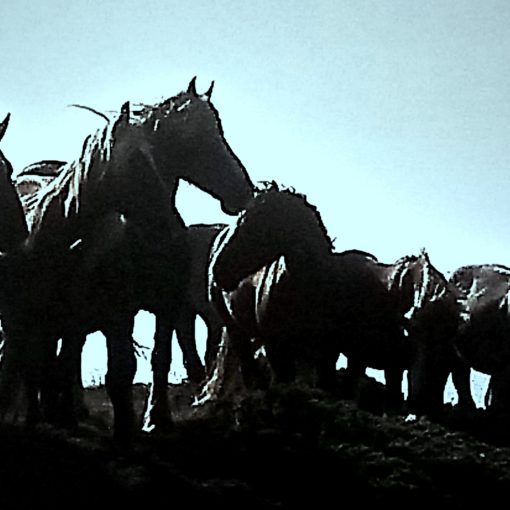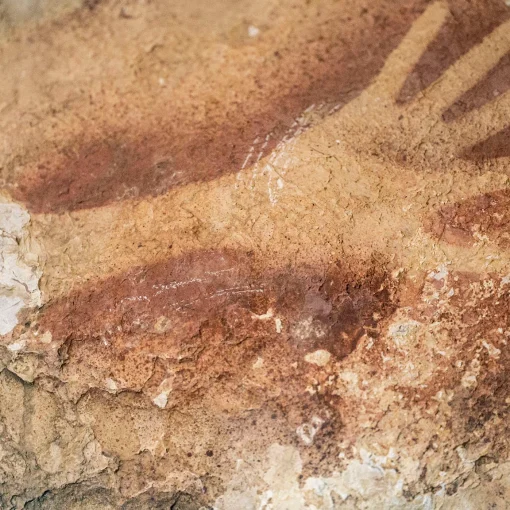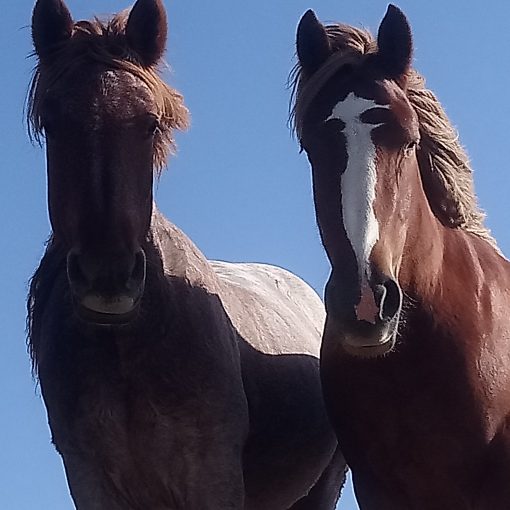It was quite a few years ago that I decided the only logo that was appropriate for The Mindful Horse (the name by which I have worked for over 10 years) was the White Horse of Uffington. N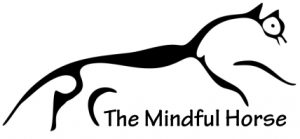 o one would ever be able to create an image to which I felt a greater connection. It feels that it is appropriate at this time to reassert that connection, and reshare something of that. To do it I am revisiting and re-working this extended blog that was originally posted on an old website of mine.
o one would ever be able to create an image to which I felt a greater connection. It feels that it is appropriate at this time to reassert that connection, and reshare something of that. To do it I am revisiting and re-working this extended blog that was originally posted on an old website of mine.
Through my life (certainly for as long as I can recall) the White Horse of Uffington has appeared to me as some kind of totem or muse, constantly reminding me of its presence whenever I have let it’s image slip from my mind. What better embodiment of the idea of a personal equine connection, and through that a tie to mother earth, than one crafted from the very soil and bed rock of this ancient land.
It is many things to many people: a celebratory image carved in ages past; a beautiful artistic creation; a representation of no longer worship deities, or some other equally plausible explanation. Whatever, this beak faced, and heavily stylized image remains largely an enigma to scholars.
We call it a horse – but is that because the animal that we recognize within its image is that of a horse (like one of those reading games with false characters and numbers, our brain fills in the gaps). In part because we recognise the existence of various horses in the chalk hillsides of England. We expect a horse, and so see a horse. That said, if it is a horse, it is also not a horse.
In addition, there is its location, sufficiently close to the brow of the hill so as not to be visible from below – in fact from the ground at all, whether close or afar. It is nearly always impossible to view the full image. The only recognizable images we have are actually taken from above. And yet, it was created in a time when humanity was, to the best of our knowledge truly land-bound. So how could it somehow have ever been intended to be seen from above?
 Some God’s eye view or an offering thereto; a shaman’s totem or heavenly way marker?
Some God’s eye view or an offering thereto; a shaman’s totem or heavenly way marker?
As one looks deeper into this image – whether physically onsite and in person, or remotely, more academically – it becomes clear that its stories, its age and its folklore is profound, woven into the living myth of the landscape that it is part of.
A few basics and a little history
The Uffington Horse is an immense creation by anybody’s standards. It is 374 ft long and 120 ft high and carved out of the shallow topsoil to exposure the clear whiteness of the underlying chalk. It sits on the ancient ridgeway path of southern England.
Now maintained by National Heritage it was traditionally kept up by a 7 year cycle of scouring festivals – no longer undertaken, what a shame!
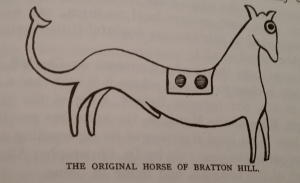
It is unlikely the image portrayed now in the Oxfordshire landscape is completely reflective of its original conception, for example modern archaeology has proved the image has changed subtly over years, and old 19th Century drawings portray it as a fully filled-in head with no eye and a “lumpy” back or top line (Jackson, 2006). Adapting and developing these images in the land is a familiar practice, for example the similarly stylised image at Bratton Hill, Westbury in Wiltshire has been changed very significant changed over the years, M Oldfield Howey (1922) provides a representation of the original White Horse of Bratton Hill, its contemporary form is very “normal” in its equine form. (See here).
The most popular and prevailing story of the creation at Uffington dates back to 871 and a celebration of the great battle of Ashdown where King Alfred and his brother Aelthelred finally defeated the Danes, a victory for Christendom, wrestling away the land and its people from pagan influence.
As we will see, this “defeat of paganism” is a recurring theme at Uffington.
Modern archaeology takes the site much further back, circa 3000 years, based upon analysis of silts around the carving and ancient coinage finds bearing similar imagery. This work connects the Horse with the Belgae and most likely a local representation of the wider European horse goddess Epona, be it Rhiannon or similar incarnation. Personally, I see some of this nurturing feminine energy in the creation of the dry valley we know as The Manger that is laid out in the landscape below the horse.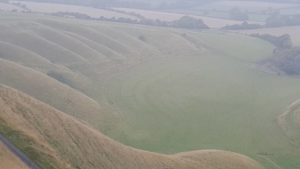
Contemporary thinking also suggests that it likely to have some kind or totem or ritual association with the tribes that inhabited the hill fort that is Uffington Castle (on the Northern flank of the same high ground).
So a view of the Horse begins to take shape, but nothing really stands as conclusive, and beyond the image we see in the hill when we are there (or in books and on the internet), the real “What, Why and When” of Uffington is without a conclusive definition.
Drawing out the meaning from the myth
The enigma that is Uffington endures. And with it, the magic; and so our fascination.
So let us reach back into the legends and stories that have been told. Too often with these ancient locations it is the stories related of them that tell us more than the dry academic facts of the historians and the archeologists.
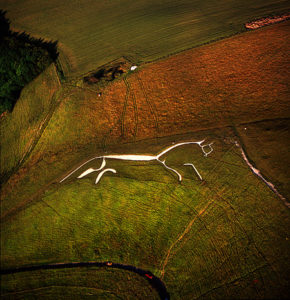
The beak horse (or hen headed steed) is actually no stranger to the culture of the ancient Britons, the great Celtic bard Taliesin’s work contains many references to “Hen headed horses”, and similar imagery has been found on ancient coinage.
In addition to the reference of Alfred’s victory, another battle connection is the mythological Mount Baden, the site of King Arthur’s twelfth and most decisive victory over the Saxons. The victory that gave birth the golden age portrayed in the tales and legends of Camelot and the Knights of the Round Table.
This places the horse within Arthurian (and therefore Avalonian) tradition. At the very heart of the mythology of the Britain. And here we see another inferred linkage to the theme of overcoming of pagan (and pre-Christian) beliefs.
Further ties to Arthurian legend cite Dragon Hill (at the foot of the escarpment of the horse) as the resting place of Uther Pendragon, Arthur’s father, and often regarded in folklore as the bridging character between old world beliefs and the modern Christianity. A theme that was developed by John Aubrey in Monumenta Britannica in 1670, which was written as a development of writings on Uther first outlined in Geoffrey of Monmouth’s History of the Kings of Britain (1136).
Pendragon meaning “Dragon’s head” or “Chief dragon” reportedly derives from the siting a comet in the heavens – either by Uther or his elder sibling Ambrosius Aurelianus.
Dragon Hill further etches itself into ancient British folklore in the tale of the English patron saint, St George. Much is written about George and whether he ever visited these shores, a Syrian mercenary (and local dragon slayer) whose name was adopted those in the holy lands on crusade, supposedly bringing back the name of their eponymous here in the Order of (or Knights of) St George.
However, it is here that the celebrated hero gives battle to the ancient dragon and saves the princesses there enslaved. That fight causes the spilling of noxious dragon-blood on the top of the hill, where this day legend has it that nothing will grow in that place. It is marked today by a patch of bare rock on the top of the hill where nothing grows.
The legends of St George and his dragon slaying heroism reflect similar tales of St Michael, whose name Christianizes many older and important pagan places across Europe, for example Mont St Michel in Normandy France and Glastonbury Tor in Somerset, England. Again we see the a reflection of the Christian defeat of paganism, in these cases physically asserting itself over the elder.
The Royal Berkshire History website develops a line that the horse is actually a representation of the dragon there slain. Not an unreasonable proposition given the importance of the dragon in the beliefs and myths of the Britons. Dragon tales are in every sense a worldwide myth (all traditional civilizations acknowledge the Dragon or some local version thereof such as the plumed serpent in South American or the Nagas in the far East. No other mythological beast is so omnipresent). This said individual tales of fire breathing beasties are no more numerous and widespread as they are in the British Isles (Richard Freeman, 2006).
Finally, for the more modern minded out there, UFOlogists consider this an important site, and the fields that stretch-out in landscape below the Horse are some of the most common locations in England for the manifestation of crop circles.
And so what is this iconic landscape telling us
Some might suggest that the Horse is hiding her message. Others might say that she is hiding nothing; perhaps it is that we have just lost the ability to see what lies before us.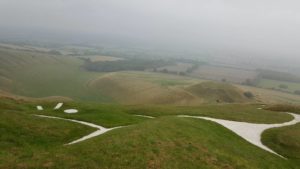
We know that these white horses have changed over the years and so it remains plausible that what resides here is more dragon in origin than equine, reshaped or re-recognised as beliefs and cultures morph. The histories and mythologies here constantly refer back to the overcoming previous beliefs frameworks, and sadly always in a violent form. It is only contemporary western belief that positions the dragon as some beast to conquered; a very real metaphor for the spread and victories of the western monotheistic model of heaven-based Christianity over the more earth-based spirits of pagan faith.
And whether dragons exist or not, whether they are pure fantasy or misunderstood mythological interpretations of comets in the heavens, or something else; they still represent ethereal energy, the prima energies of mother earth.
In my meditations over the years I have come across a repeated message on many occasions “the dragon’s lie sleeping within the horses”, this is not to say there has to be a dragon under this hill, or that there are dragons sleeping in our beloved equines, but there is an intimate link for us through our horses to essence of life on this planet.
Horses form a forgotten connection to the land, they are portal for those of us that which to connect to world around us. They are a doorway that we can all step through, they illuminate a resource that is accessible within each of us.
There is a spirituality at Uffington. It is a place just to be and to connect, not to theorise or define. It is about the vision – an opportunity for the spiritual to travel and reflect upon the form of their Gods or Spirits (Horse, Dragon or whatever) – as an English mirror (perhaps) of the landscape patterns of Nazca in Peru.
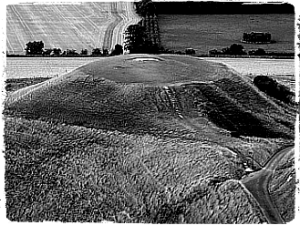 The whole landscape is a creation here, whether in the less well recognised undulating ripples in the landscape of manger reaching off to the north-east Dragon Hill below. Dragon Hill’s shape strangely alien and angular in a landscape of otherwise gentle rolling scenery; perhaps it represents a place from which to travel to some Otherworld, a safe starting point, or the gateway to the heart of the spirits of Uffington and whatever they represent. Its circle of bare-chalk perhaps a place from which to reach out to the ethereal spirit that bares the form of a horse on the hillside above.
The whole landscape is a creation here, whether in the less well recognised undulating ripples in the landscape of manger reaching off to the north-east Dragon Hill below. Dragon Hill’s shape strangely alien and angular in a landscape of otherwise gentle rolling scenery; perhaps it represents a place from which to travel to some Otherworld, a safe starting point, or the gateway to the heart of the spirits of Uffington and whatever they represent. Its circle of bare-chalk perhaps a place from which to reach out to the ethereal spirit that bares the form of a horse on the hillside above.
Whatever, for me, it is a place that inhabited by psyche long before I visited it. Like some perennial deja-vu, whose image has formed haunting chimera within both night and day-dreams since I can remember.
It is a place without questions, and yet a place full of answers. In so many ways it is home.
(c) The Mindful Horse
* I do not own the images shared herein


